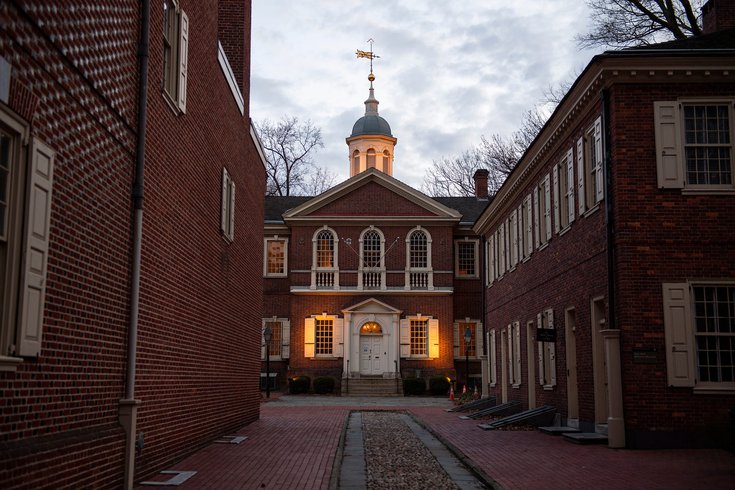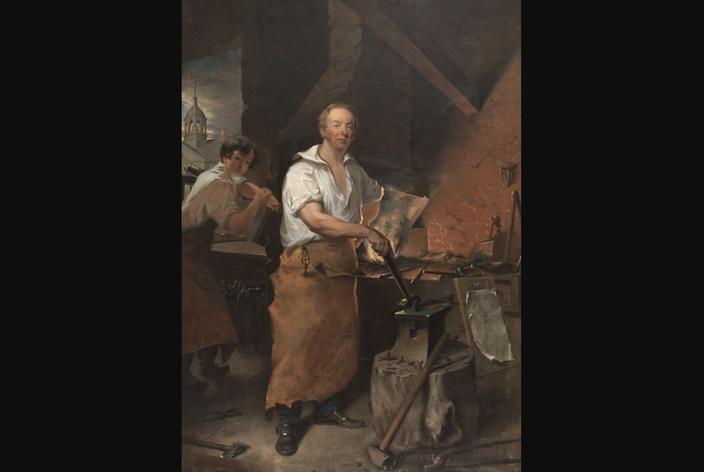
August 31, 2023
 JOE LAMBERTI/USA TODAY NETWORK ATLANTIC GROUP
JOE LAMBERTI/USA TODAY NETWORK ATLANTIC GROUP
The first bank robbery in the U.S. happened in Philly on Aug 31, 1793. The target was the Bank of Pennsylvania, at time located inside Carpenters' Hall, pictured above, in what is now Old City. The thieves stole more than $162,000 and never went to prison, but for a time, the wrong man, a blacksmith named Patrick Lyon, was accused and charged.
The man credited with the first big bank robbery in America was, frankly, bad at crime.
Isaac Davis made off with $162,821 — or $3 million, in today's money — from the vaults of the Bank of Pennsylvania sometime in the middle of the night on Aug. 31, 1798. Davis was a member of the Carpenters' Company, the guild that owned and rented Carpenters' Hall, the historic Old City building at 320 Chestnut St., out to various businesses seeking temporary homes. One of the those businesses was the bank, which had just installed new fittings and locks on its vault doors. With the help of a bank porter, Davis had made out with the money scot-free — until he began depositing some of the stolen loot back into the Bank of Pennsylvania. The mistake was entirely his; the porter had died of yellow fever just days after the robbery.
Davis's failed criminal career bore little consequence for him. As the nephew of a powerful judge, he was allowed to leave Philadelphia without so much as an arrest once he returned the money. But it forever changed the life of a blacksmith named Patrick Lyon, who had been falsely accused of the crime and nearly died in prison before anyone believed him.
Lyon had only been in America for five years when the heist happened, but the Scotsman had managed to build a successful business for himself in that time. His work attracted the notice of the Bank of Pennsylvania, which had recently relocated to Carpenters' Hall after a failed theft attempt at its old headquarters on Lodge Alley. Understandably, the bank wanted its vault locks changed.
Lyon completed the work and then left the city, seeking to escape the spread of yellow fever. He and his apprentice set out for Lewes, Delaware, on Aug. 26, but the trip would be cut short as word spread of the robbery and the prime suspect: the man who had changed the locks.
The blacksmith returned to Philadelphia to clear his name, but the bank, embarrassed by the entire ordeal, wasn't interested in his side of the story. They wanted the perpetrator punished, the whole matter buried. So Lyon was sent to Walnut Street Prison, with a bail of $150,000, or nearly $2 million adjusted for inflation.
"This was outrageous," Dan Barto, a docent for Carpenters' Hall, said. "I think it was just to try to shake the trees a bit, to have him confess to something like that, to understand he was going to be in there a long time. I mean, what was stolen was $162,000 and they made the bail $150,000. So that was extreme."
Lyon continued to protest his innocence, but matters only grew worse for him. He spent three months in prison, much of it in solitary confinement, where he had little to do but pace his 12-by-4-foot cell and read the Bible or a book of poems, the only diversions he was allowed. (Singing or whistling got him sent to "a dungeon.") He couldn't stomach the food, and his hair began to fall out. As he grew sick with yellow fever, he became convinced he would die there and composed his last will and testament — including a proposed inscription for his tombstone, which he printed in his eventual memoir:
"My sledge and hammer's both declin'd,
My bellows too have lost their wind;
My fire's extinct, my forge decay'd,
And in the dust my vice is laid;
My coal is spent, my iron's gone,
My nails are drove, my work is done."
While Lyon waited for death in prison, Davis was confronted about his unusual deposits. He quickly confessed and promised to return the money in exchange for a full pardon from the governor of Pennsylvania, a deal his uncle, Judge Benjamin Brannon, helped facilitate. But the bank officials still believed Lyon had copied the keys to the vault, and left him in prison for several more weeks after Davis's confession. No wonder Lyon believed he had "some secret enemy" at the Bank of Pennsylvania.
"Part of the reason why they held him in jail was because they thought he was ingenious," Barto explained. "That he could have manufactured these keys, these duplicates. Apparently he was quite an expert in this field. He had a lot of inventions, he always seemed to be working on something in his workshop. And so he was always trying to prove his craft."
When the charges against Lyon were finally dismissed, he set out to tell his story in a book, which was published in 1799. It opened with a missive "to the public" setting up Lyon's story as an all-too-common narrative of the rich and powerful versus the honest working class.
"It is an observation I long have made, that the great when they have power, will often make a wrong use of it," Lyon wrote. "And that those who are inferior in rank, have very little change of justice when opposed to them; as riches furnish a variety of means both to elude and oppose the effective force of the law."
A few years later, Lyon continued his campaign to restore his name by suing the president of the Bank of Pennsylvania, two other bank officials, the city constable and an alderman for damages over false imprisonment. A jury of merchants, grocers and construction workers found the defendants guilty in the summer of 1805. The court ordered them to pay $12,000 to Lyon, which was eventually bargained down to $9,000.
Philadelphians watched the case with great interest, and the anger towards the politicians and bankers involved is apparent in an 1808 book chronicling the case. The grand jury found Brannon's backdoor dealings to help his nephew in particular "highly reprehensible, if not criminal" and when the verdict was returned in favor of Lyon, a "universal clamor of exultation took place among the audience," the loudest the reporter remembered in a courtroom.
"This basically, from what I understand, took over the town," Barto said of the case.
With his $9,000, Lyon restored his decimated business and even commissioned an oil portrait of himself. "Pat Lyon at the Forge" now hangs in the Pennsylvania Academy of Fine Arts, nestled among other paintings of presidents, royalty and great writers and composers. Isaac Davis and his crooked uncle are nowhere to be found.
The artist John Neagle painted “Pat Lyon at the Forge” in 1829.
Follow Kristin & PhillyVoice on Twitter: @kristin_hunt
| @thePhillyVoice
Like us on Facebook: PhillyVoice
Have a news tip? Let us know.
 Provided image/Pennsylvania Academy of Fine Arts
Provided image/Pennsylvania Academy of Fine Arts